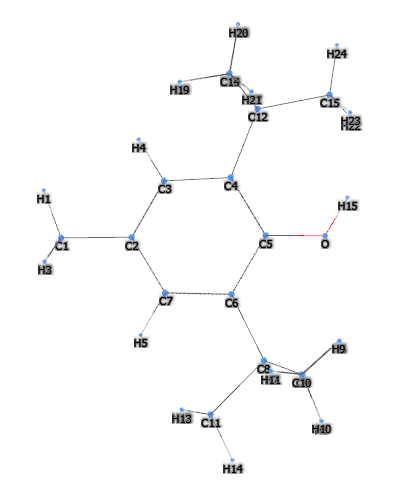| "Descrizione" by Ark90 (12432 pt) | 2023-Apr-11 16:44 |
Review Consensus: 10 Rating: 10 Number of users: 1
| Evaluation | N. Experts | Evaluation | N. Experts |
|---|---|---|---|
| 1 | 6 | ||
| 2 | 7 | ||
| 3 | 8 | ||
| 4 | 9 | ||
| 5 | 10 |
E321 (BHT or Hydroxy toluene butylate or Butylated hydroxytoluene or Toluene hydroxylated butylate), is an organic chemical compound, lipophilic phenol, obtained synthetically by the reaction of 4-methylphenol with isobutylene and catalysed by sulphuric acid.
It appears as a white, stable but photosensitive powder. Flammable. Incompatible with oxidising agents, acid chlorides, bases, brass, acid anhydrides, copper, copper alloys, steel.

What it is used for and where
Food
A synthetic antioxidant generally considered safe in food. It has the ability to control free radicals by eliminating peroxyl radicals and to control free radical generation by inhibiting or retarding oxidation (1). The FDA-authorised maximum use dose is 0.02% in meat and meat products from the meat processing industry.
Ingredient included in the list of European food additives as E321, antioxidant.
Cosmetics
It is included in formulations of shower gels, shampoos, lipsticks as an antioxidant to improve the stability of fat-soluble cosmetics and prevent their deterioration.
Other uses
Also used in petroleum products, rubber, plastic foam as an antioxidant stabiliser, polyester resin, ABS resin, polyethylene, polystyrene, cellulose, transformer oil, white and clear latex.
In natural rubber processing it acts as an antioxidant and stabiliser
Safety
BHT is a skin and eye irritant but no conclusions can be drawn on the additive's potential for skin sensitisation. It is considered safe by EFSA in animal feed (2) but this study recommends monitoring and limiting its use (3) and suggests that BHT consumption should not exceed 0.5 mg/kg body weight (4).
For more information:
Typical commercial product characteristicsBHT Butylated Hydroxy Toluene
| Appearance | White powder |
| Boiling Point | 265ºC |
| Melting Point | 69-71ºC |
| Flash Point | 127ºC |
| Density | 1.048 |
| PSA | 20.23000 |
| Vapor Pressure | 0.0±0.6 mmHg at 25°C |
| Vapor density | 7.6 |
| LogP | 5.32 |
| Refraction Index | 1.499 |
| Sulphate SO4 | ≤ 0.002 w/% |
| Arsenic | ≤ 1 mg/kg |
| Cauterized residue | ≤ 0.004 w/% |
| Free phenol (p-cresol) | ≤ 0.01 w/% |
| Water | ≤0.1% |
| Safety |  |
 |  |
 |  |
- Molecular Formula C15H24O
- Linear Formula [(CH3)3C]2C6H2(CH3)OH
- Molecular Weight 220.356 g/mol
- Exact Mass 220.182709
- UNII: 1P9D0Z171K
- CAS: 128-37-0
- DSSTox Substance ID
- IUPAC 2,6-ditert-butyl-4-methylphenol
- InChl= 1S/C15H24O/c1-10-8-11(14(2,3)4)13(16)12(9-10)15(5,6)7/h8-9,16H,1-7H3
- InChl Key NLZUEZXRPGMBCV-UHFFFAOYSA-N
- SMILES CC1=CC(=C(C(=C1)C(C)(C)C)O)C(C)(C)C
- EC Number: 204-881-4
- FEMA Number: 2184
- PubChem Substance ID 329749182
- MDL number MFCD00011644
- Beilstein Registry Number 1911640
Synonyms
- 2,6-Di-tert-butyl-4-methylphenol
- Butylated hydroxytoluene
- Butylhydroxytoluene
- 2,6-Di-tert-butyl-p-cresol
- 2,6-Di-t-butyl-4-methylphenol
- Ionol
- Parabar 441
- Paranox 441
- 2,6-Di-tert-butyl-4-cresol
- DBPC
- Dibunol
- Stavox
- Phenol, 2,6-bis(1,1-dimethylethyl)-4-methyl-
- BHT
- Ionol CP
- Antrancine 8
- Butylated hydroxytoluol
- Vulkanox KB
- Impruvol
- Topanol
- Dalpac
- 2,6-ditert-butyl-4-methylphenol
- Di-tert-butyl-p-cresol
- Dibutylated hydroxytoluene
- Deenax
- Ionole
- Vianol
- Antioxidant KB
- 3,5-Di-tert-butyl-4-hydroxytoluene
- Antioxidant 4K
- Sumilizer BHT
- Topanol O
- Topanol OC
- Vanlube PC
- Antioxidant DBPC
- Sustane BHT
- Tenamene 3
- Vanlube PCX
- Antioxidant 29
- Antioxidant 30
- Nonox TBC
- Tenox BHT
- Chemanox 11
- Ionol 1
- Agidol
- Catalin CAO-3
- Advastab 401
- Ionol (antioxidant)
- BUKS
References______________________________________________________________________
(1) Zahid MA, Eom JU, Parvin R, Seo JK, Yang HS. Changes in Quality Traits and Oxidation Stability of Syzygium aromaticum Extract-Added Cooked Ground Beef during Frozen Storage. Antioxidants (Basel). 2022 Mar 11;11(3):534. doi: 10.3390/antiox11030534.
(2) EFSA Panel on Additives and Products or Substances used in Animal Feed (FEEDAP), Bampidis V, Azimonti G, Bastos ML, Christensen H, Dusemund B, Fašmon Durjava M, Kouba M, López-Alonso M, López Puente S, Marcon F, Mayo B, Pechová A, Petkova M, Ramos F, Sanz Y, Villa RE, Woutersen R, Finizio A, Teodorovic I, Aquilina G, Bories G, Gropp J, Nebbia C, Innocenti M. Safety and efficacy of a feed additive consisting of butylated hydroxytoluene (BHT) for all animal species (Katyon Technologies Limited). EFSA J. 2022 May 10;20(5):e07287. doi: 10.2903/j.efsa.2022.7287.
(3) Abou-Hadeed AH, Mohamed AT, Hegab DY, Ghoneim MH. Ethoxyquin and Butylated Hydroxy Toluene Distrub the Hematological Parameters and Induce Structural and Functional Alterations in Liver of Rats. Arch Razi Inst. 2021 Dec 30;76(6):1765-1776. doi: 10.22092/ari.2021.356439.1844.
(4) Lobo V, Patil A, Phatak A, Chandra N. Free radicals, antioxidants and functional foods: Impact on human health. Pharmacogn Rev. 2010 Jul;4(8):118-26. doi: 10.4103/0973-7847.70902.
| Evaluate |

